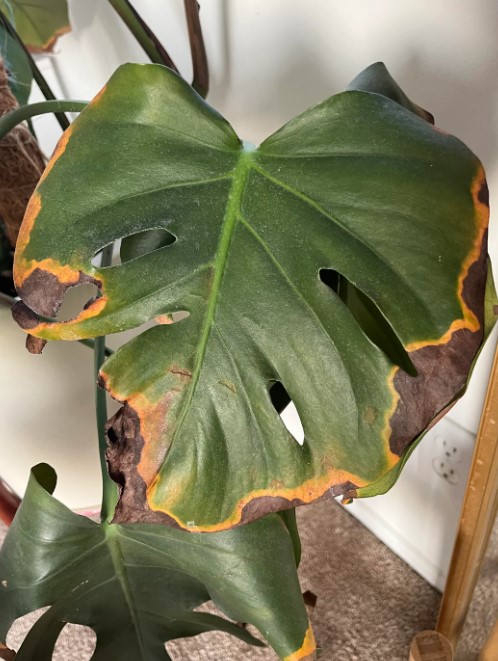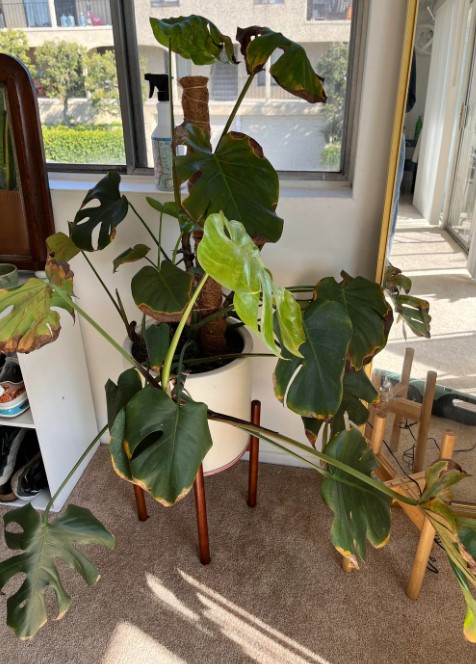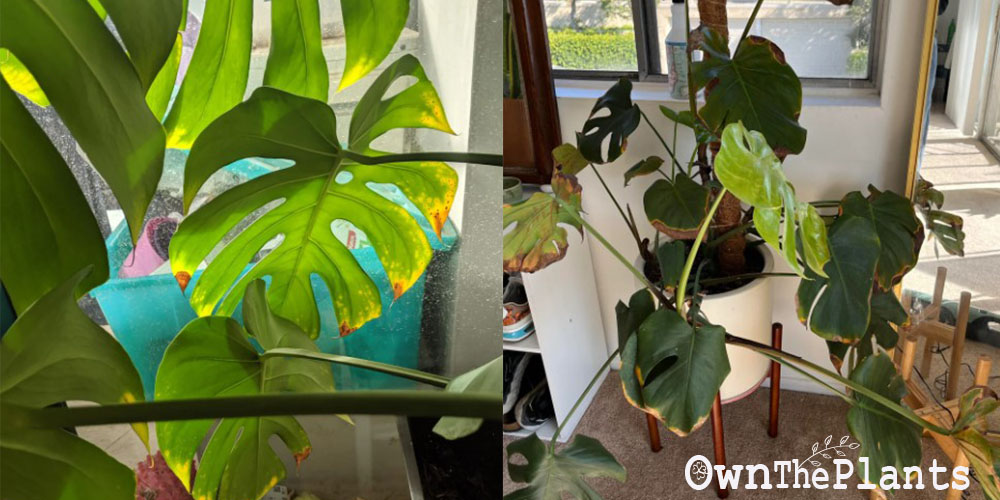The Monstera plants, popularly known as the Swiss Cheese Plant, is among the most common houseplants there is.
Their popularity is mainly due to their unique huge, verdant foliage that has distinct holes and fenestrations, hence the nickname. These plants are sure to be an eye-catcher, bringing an exotic, tropical vibe to any space.
Aside from their beauty, the Monstera plants can also be low-maintenance. They have minimum requirements, hence, they are perfect plants even for plant novices.
However, it’s not all the time that this plant is healthy and thriving. Like all other plants, they too are very susceptible to plant problems, especially browning of leaves.
If you ever own a Monstera plant or you are still planning to have one, you may notice the apparent browning of leaves. It may just be a normal progression of your plant, however, it can also be a sign of a more serious concern.
But worry no more!
In this article, we will delve into the main reasons why this problem occurs to your plant, how to fix it, and how to prevent having it in the future.
Let’s dive right in!
Why Are My Monstera Plant Leaves Turning Brown?
All plant problems arise from one general cause; they are not grown in the right environmental conditions. The browning of your Monstera plant leaves is no exception.
However, to fix this issue, you need to determine which environmental factor is not suited for your plant. These factors could be light, water, humidity, temperature, soil quality, and pathogens among others.
The browning of leaves of Monstera plants can be due to watering or light problems, inappropriate levels of humidity, diseases, or transplant shock.
Each of these reasons has different solutions, hence, it is important that you are able to pinpoint what’s causing the problem to your plant.
Keep reading below as we go into each of these factors so that you will know what to look out for and how to fix it accordingly.
1. Watering Problems
Many plant problems are caused by improper watering routine, like the browning of leaves.
Overwatering or underwatering your plant is detrimental to its health since water is essential for all plant metabolic processes. Excessive or limited amounts of water will surely bring problems to your plant.
Overwatering
Giving too much water is easily committed by most plant growers, hence, Monstera issues are often associated with overwatering.
If you have noticed dark brown spots on your Monstera leaves, then it is most likely caused by overwatering.
When your plant is overwatered, the roots are soaked in water, depleting oxygen resources that lead to root rot. When this happens, your plant will not be able to soak in nutrients and moisture.
This makes your plant unstable, thus leading to browning of leaves. In severe cases, root rotting caused by overwatering can even result in death.
Underwatering

On the other hand, insufficient amounts of water can also be a cause of brown leaves of the Monstera plant.
If the browning of the leaves is coupled with crispy edges and brown tips, then your issue is caused by underwatering.
Remember that your plant is a tropical plant that thrives in rainforests, thus it really dislikes being underwater.
An underwatered Monstera will have an issue with absorption of nutrients. This makes the roots of your plant dehydrated and eventually die.
Watering Problems Fix
Watering problems such as overwatering and underwatering happen because most plant owners tend to strictly follow a fixed watering routine.
This should not be the case since the amount of water needed by the plant is dependent on many environmental factors.
To fix these issues, rectify your watering routine and do not adhere to a strict schedule. Always check the soil of your plant before giving it water.
To do this, stick your finger to the top 2 to 3 inches of soil. If the soil is still moist, then you should skip watering until it gets dry again. If it is already dry, then give it water gradually.
You can also check the soil mixture of your plant and see if it drains well.
If you notice that the water stays for a long period of time and the soil becomes heavily compacted, or if the soil is too porous and drains really fast before the plant absorbs the moisture, you may need to repot your plant to a fresh soil that is light, airy, and well draining.
2. Extreme Sunlight
The Monstera plants are not tolerant to direct sunlight exposure. They hail from tropical rainforests where light is filtered by the jungle canopy, preventing direct light from hitting your plant most of the time.
If your plant is on a spot with direct light and has scorched leaves, then the plant issue is caused by excessive sunlight.
The burnt leaves will not recover anymore, but your plant can still be saved from getting serious damage.
An excessive sunlight is a serious issue, especially during the summer season when the rays of the sun are more intense. During the winter season, it is less of a problem since sunlight gets less intense.
Extreme Sunlight Fix
To fix this issue, relocate your plant to a more suitable spot. If you are growing this indoors, do not place it directly in a south facing window as this place is too bright for your plant.

A west or east-facing window is more appropriate for your plant. You can put it three feet away from windows to prevent leaf burns.
You may also use a sheer curtain or window blinds to filter the light first before hitting the plant.
3. Low Humidity
As a tropical plant, your Monstera plant loves high humidity. If the browning is concentrated on the leaf edges, then your Monstera has a problem with the humidity. This signifies that the moisture level is extremely low for your plant.
When your plant is experiencing low humidity, leaf browning with dry spots can occur.
The size and number of the spots usually depend on how dry the air is. The leaves can also curl at the tips and may become crispy.
Low Humidity Fix
You can maintain the optimum humidity level for your Monstera plant by employing some techniques, especially if you are growing it indoors. An efficient humidifier can work wonders on your plant.
However, if you are on a tight budget, then misting your plants with clean water regularly is also helpful. Just ensure that the aeration is good since stagnant water can rot your leaf.
You may also put a pebble tray with water at the bottom of your plant pot to improve humidity.
Alternatively, for fast relief, you can put your plant inside your bathroom for at least five minutes and allow water steam to be absorbed by your plant.
4. Air Drafts
Your Monstera plant can also become fussy when the air around them is not stable.
A significant drop in temperature due to air drafts damages your plant leaves and turns them brown. Depending on the length of exposure, the severity of the damage varies.
Air Draft Fix
Relocate your plant at once, especially if it is near appliances that emit air drafts such as air conditioners, refrigerators, and radiators.
If possible, move your plant to a room where the temperature is 65°F-90°F. Remove the leaves that are more than 50% brown to allow fresh, healthy growth.
5. Fungal Disease
There are many harmful pathogens anywhere that can damage your plant. Fungi are one of them.
If you have observed the brown spots on your Monstera leaves having yellow rings or halos around, then surely this is a case of fungus disease.
The growth of fungus is heavily encouraged by a wet environment, thus it is really important that your plant is not soaked in water for too long, aside from the potential root rotting.
Extreme fungal infestation can cause leaves to die, and consequently, your plant if not taken action immediately.
In general, fungal diseases are consequences of lack of light and poor aeration of the soil and in the environment.
Fungal Problem Fix
If your plant issue is caused by a fungal disease, immediately isolate your plant to avoid further spreading of the disease to other plants.
Remove the infected leaves and discard it properly. Spray fungicides or horticultural oils such as neem oil to your plant and to the rest of your garden regularly.
You can also relocate your plant to a space with better air circulation if you suspect that aeration is one cause.
You may also avoid misting your plant for the succeeding days while recovering so that fungal growth will not be encouraged.
6. Quality of Water
Sometimes, your Monstera plant reacts differently to tap water, especially if the tap water in your area is hard and chemical traces like fluoride are still present.
The fluoride can cause harm to your plant by developing brown leaf tips.
Quality of Water Fix
If you suspect that the water quality is the main cause of your plant issue, then it would be best if you stop using it first.
You may collect rainwater to water your plant or if possible, distilled water.
7. Transplant Shock
Transplanting your Monstera plant can also cause browning of leaves, especially if it is done improperly and the roots have been damaged.
More so, a newly transplanted plant experiences stress in new growing conditions. The stress is manifested in the browning of leaves.
Transplant Shock Fix
There is really no specific fix for transplant shock but to wait for your plant to get adjusted to its new environment.
While your plant is in an adjustment period, you should give it proper care and nourishment to make it healthy.
You may remove damaged leaves to encourage fresh growth. It is also important to note that during this stage, you should avoid fertilizing first. Wait for your plant to become more established before feeding it.
You might like: Why Does My Monstera Plant Not Have Holes In The Leaves?
Final Thoughts
Monstera plants are widely known for their unique leaf architecture and design. The natural holes and leaf fenestrations make these plants adorable.
However, like all plants, your Monstera plant can also experience problems like browning of the leaves.
Now that you know how to identify the underlying cause and how to specifically address them, surely, there will be a less chance that you encounter this problem again.
The key to being a good plant owner is understanding and learning more about your plant. The more that you know, the more that you can give it proper love and care.
If you have something to share about your Monstera experiences, then feel free to comment down below. Let the whole world know about your plant journey and inspire others!
